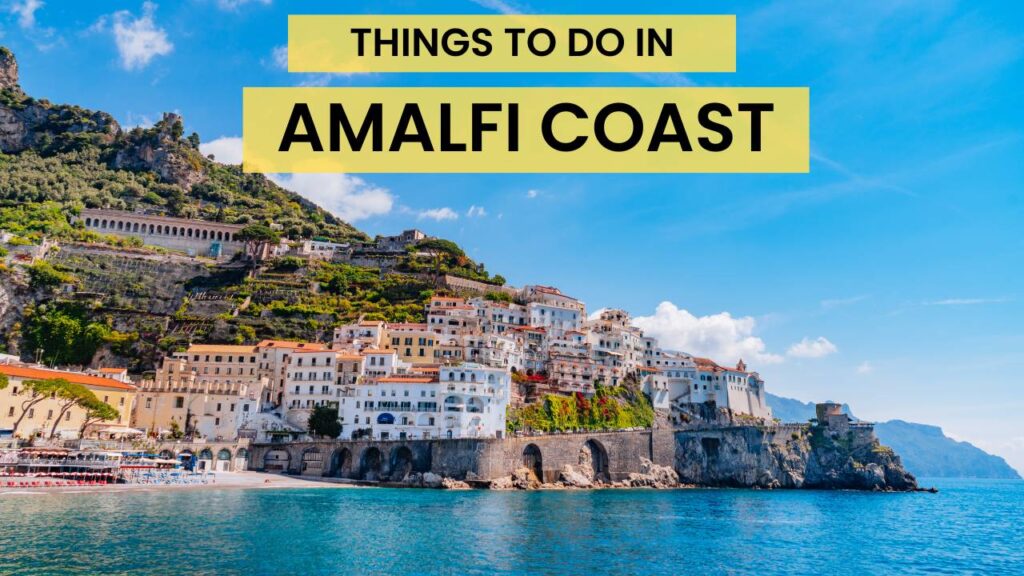Pick best things to do in Amalfi Coast, including where to stay, how to get there, and the must-visit destinations, get ready to experience the beauty and magic of the Amalfi Coast like never before.
Amalfi Coast is a stunning stretch of coastline in southern Italy, offering a perfect blend of natural beauty, rich culture, and historic charm. Visiting for the first time or returning for a new experience, this region offers a variety of activities that suit all types of travelers.
Where is the Amalfi Coast?
The Amalfi Coast is located in the Campania region of southern Italy. It stretches along the Sorrentine Peninsula, running from the town of Sorrento in the west to Salerno in the east. This coastline, about 30 miles in length, is characterized by dramatic cliffs, small coves, and picturesque villages. The Amalfi Coast is surrounded by the Tyrrhenian Sea on one side and lush green hills on the other, offering breathtaking views. The coastline is dotted with beautiful towns such as Positano, Amalfi, Ravello, and Praiano, each with its own unique charm.
How to Get to the Amalfi Coast?
To reach the Amalfi Coast, you have several travel options depending on your starting point and preferred mode of transportation.
By Air: Fly into Naples International Airport (Capodichino), located about 30 miles (48 km) north of the Amalfi Coast. From there, take a taxi, private transfer, or shuttle, and you’ll arrive at your destination within an hour to an hour and a half.
By Train: Arrive by train at Salerno, located around 35 miles (56 km) from the Amalfi Coast. From Salerno, catch a local bus or ferry to towns like Amalfi, Positano, or Ravello.
By Sea: For a scenic journey, board a ferry from Naples (about 25 miles/40 km away), Sorrento (about 12 miles/20 km away), or other nearby towns. Ferries operate in the summer months, offering stunning views of the coastline.
Things to Be Aware of on the Amalfi Coast
Before start your journey, here are a few things to keep in mind to ensure a smooth and enjoyable trip:
- Narrow Roads and Traffic: The roads along the coast are narrow, winding, and often crowded, especially during the summer months. Traffic can become congested, and parking spaces are limited. If you plan to drive, be ready for tight turns and slow-moving traffic. Use local buses or hire private drivers for a stress-free exploration of the region.
- Crowds During High Season: The Amalfi Coast attracts a large number of tourists, particularly in the summer. To avoid the crowds, consider visiting during the shoulder seasons in spring or fall when the weather remains pleasant and the region is less crowded.
- Cost: Known for its luxury accommodations and high-end dining, the Amalfi Coast can be a costly destination. Can find more affordable options in smaller towns like Praiano and Ravello.
- Hiking and Steep Terrain: The coastline features hills and steep terrain, especially in towns like Positano and Ravello. Be ready for lots of walking and wear comfortable shoes. Trails such as the Path of the Gods provide spectacular views but can be physically demanding.
Where to Stay on the Amalfi Coast
Finding the perfect place to stay along the Amalfi Coast can shape your entire experience, as each town offers its own unique charm, atmosphere, and convenience. Looking for luxury, local culture, or peaceful hideaways, the region has accommodations to suit every type of traveler.
Positano – For Luxury and Iconic Views
Chasing postcard-perfect views and upscale comfort, Positano stands out as the crown jewel of the coast. With its pastel-colored buildings cascading down cliffs toward the sea, Positano delivers breathtaking scenery from almost every angle. Luxury hotels dominate the cliffsides, offering private terraces, infinity pools, and exceptional service.
Town also caters to fashion lovers and foodies, with high-end boutiques, artisan shops, and gourmet dining options scattered throughout its narrow, winding streets. Keep in mind that Positano is one of the more expensive areas to stay, but the combination of beauty and elegance justifies the cost for many visitors.
Amalfi – For History, Accessibility, and a Central Location
Staying in Amalfi places you right in the heart of the coastline, making it a practical and scenic base for exploring nearby towns. As one of the larger towns, Amalfi combines a rich historical backdrop with stunning seaside charm. Visitors can choose from a range of mid-range to high-end hotels, many of which sit within walking distance of landmarks like the Amalfi Cathedral and the bustling Piazza del Duomo.
Accommodations often feature sea views, rooftop terraces, and easy access to ferries and buses, making travel between towns seamless. The lively harbor area, combined with the cultural heritage of the town, makes Amalfi a balanced option for both convenience and atmosphere.
Ravello – For Peace, Romance, and Elevated Views
Perched high above the coast, Ravello offers a completely different pace from the busier seaside towns. It’s the perfect retreat for travelers seeking quiet elegance, cooler air, and panoramic views of the Tyrrhenian Sea. Known for its timeless beauty and artistic history, Ravello is home to several historic villas turned boutique hotels, including Villa Cimbrone and Villa Rufolo—both surrounded by stunning gardens and architectural splendor.
Many accommodations in Ravello focus on tranquility, with serene courtyards, scenic balconies, and charming interiors that reflect the region’s artistic soul. It’s an excellent choice for couples, honeymooners, or anyone looking to escape the crowds while still staying close to the action.
Sorrento – For Versatility and Easy Connections
Though not technically part of the Amalfi Coast, Sorrento lies just a short drive away and serves as a strategic gateway to the region. With more extensive transportation links, including a train station, ferry port, and frequent buses, Sorrento allows for easy travel to places like Positano, Capri, Naples, and Pompeii. It’s also generally more affordable than the core Amalfi Coast towns, offering a wide selection of hotels, guesthouses, and self-catering apartments.
Luxembourg City Travel Guide: 11 Authentic Hotspots & Things to Do
Town blends traditional charm with modern convenience, and its cliffside hotels provide sweeping views of the Bay of Naples. Sorrento is ideal for travelers looking to the wider region without staying in the more crowded or expensive towns along the coast.
Best Things to Do in the Amalfi Coast
There are countless things to do in Amalfi Coast, from exploring charming towns and indulging in delicious local cuisine to enjoying outdoor activities. Here’s a detailed look at the top experiences:
- Visit Sorrento
- See Amalfi
- Visit Amalfi Coast Towns
- Enjoy Italian & Neapolitan Food
- Visit Pompeii
- See Positano
- Stay at an Agriturismo
- Drive the Amalfi Coast Road
- Visit Capri
- Spot Vesuvius
- Go Hiking
- Relax on the Beach
- See Castellammare di Stabia
- View Capri from the Coast
- Shop Fresh Produce
- Take a Boat Tour
- Drink Limoncello
1. Visit Sorrento
Start your journey in Sorrento, a charming coastal town that offers a perfect blend of history, nature, and local flair. As you walk through its bustling piazzas and scenic alleyways, the aroma of fresh lemons fills the air—this town is the birthplace of the world-famous Limoncello. Enjoy artisanal shops selling handmade ceramics and leather goods, or take a seat at a cliffside café to sip espresso while gazing out at the Bay of Naples.
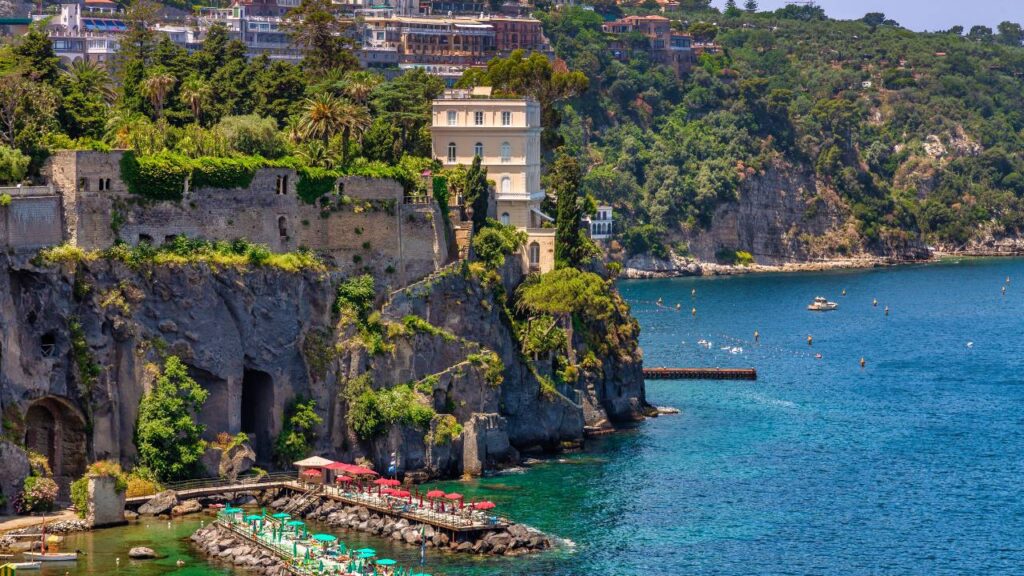
Head to Villa Comunale to unwind in the public gardens, where panoramic views of the coastline and Mount Vesuvius stretch across the horizon. With its unique character and welcoming vibe, Sorrento sets the tone for an unforgettable coastal adventure.
2. See Amalfi
Step into the historic town of Amalfi, where rich maritime history and striking architecture meet in the heart of the coast. Climb the majestic staircase to visit the Cathedral of Saint Andrew, a stunning mix of Romanesque and Moorish design dating back to the 9th century. Inside, you’ll find sacred relics, intricate mosaics, and a peaceful cloister.
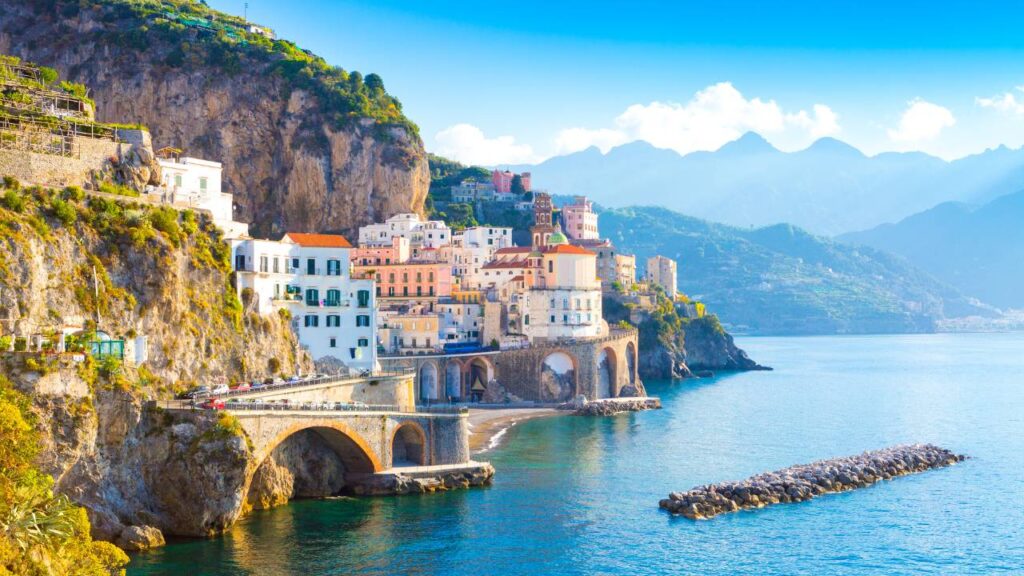
A short walk from the main square takes you to the Paper Museum, where you can see how Amalfi’s ancient paper-making tradition still lives on. Wander the vibrant piazzas lined with cafés and boutiques, and savor fresh seafood at one of the harborfront restaurants. The town’s lively atmosphere and cultural heritage make it a must-visit destination.
3. Visit Amalfi Coast Towns
As you travel along the coastline, take time to visit the region’s many iconic towns, each with its own charm and rhythm. In Positano, colorful buildings tumble down the cliffs in a picturesque cascade, leading to a lively beach lined with sunbeds and beachside bars. Lose yourself in its narrow pathways filled with boutique shops and art galleries.
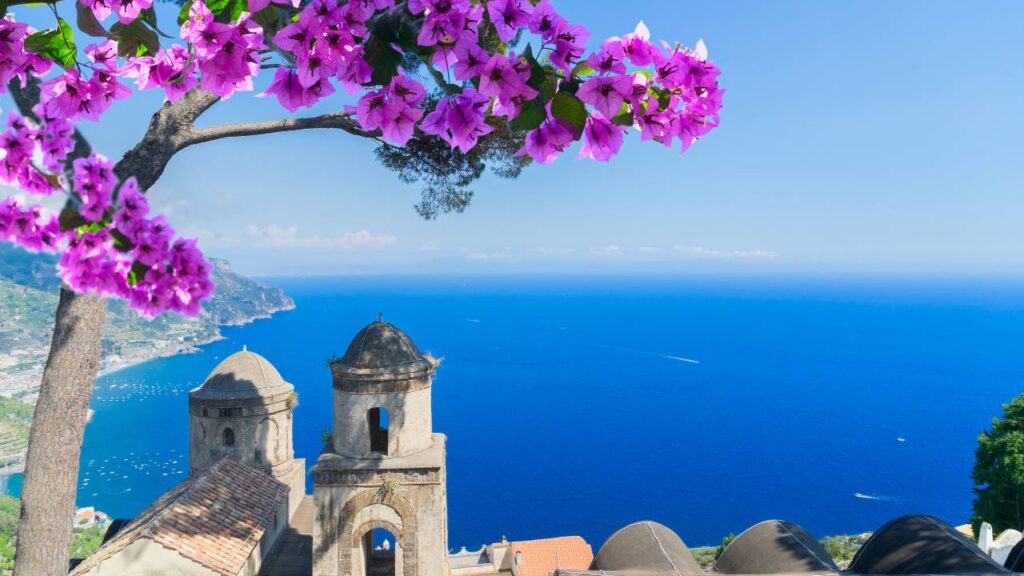
Head uphill to Ravello, where you’ll enjoy a more serene atmosphere surrounded by lush gardens and historic villas like Villa Rufolo and Villa Cimbrone. These spots offer some of the most breathtaking views in the region. For a more laid-back experience, visit Praiano or Minori, where you’ll find quiet beaches, friendly locals, and authentic Italian hospitality away from the larger crowds.
4. Enjoy Italian & Neapolitan Food
Dining on the Amalfi Coast becomes a feast for the senses with every meal. Local restaurants prepare dishes using fresh ingredients from land and sea—think grilled fish caught the same day, pasta with clams, and creamy mozzarella. Neapolitan pizza stands out as a culinary highlight, served hot with a perfectly blistered crust and simple, flavorful toppings.

Many restaurants offer alfresco dining, allowing you to eat while overlooking dramatic sea views or quaint village squares. Cap off your meal with a glass of Limoncello, made from locally grown lemons, served as a refreshing digestif. Whether you’re grabbing a quick bite at a trattoria or indulging in fine dining, the region’s cuisine never fails to impress.
5. Visit Pompeii
Take a short journey inland to uncover the ancient city of Pompeii, frozen in time by the catastrophic eruption of Mount Vesuvius in 79 AD. As you walk through the remarkably preserved ruins, you’ll pass by centuries-old homes, temples, and marketplaces that tell the story of Roman life. Marvel at the frescoes still visible on the walls, and step inside restored villas to admire their inner courtyards and mosaics.

The site’s amphitheater, public baths, and the haunting plaster casts of victims serve as powerful reminders of both civilization’s achievements and nature’s force. Easily accessible by train or car from the coast, Pompeii offers a rare and moving glimpse into the past that’s well worth the visit.
6. See Positano
Positano effortlessly captures the essence of the Amalfi Coast with its dramatic cliffside setting, vibrant buildings, and sweeping views of the Tyrrhenian Sea. As you approach the town—whether by car or boat—the first glimpse of its pastel-colored buildings cascading down the hillside is unforgettable. Wander through the steep, narrow streets where every turn reveals a picturesque terrace, a blooming bougainvillea, or a breathtaking sea view.
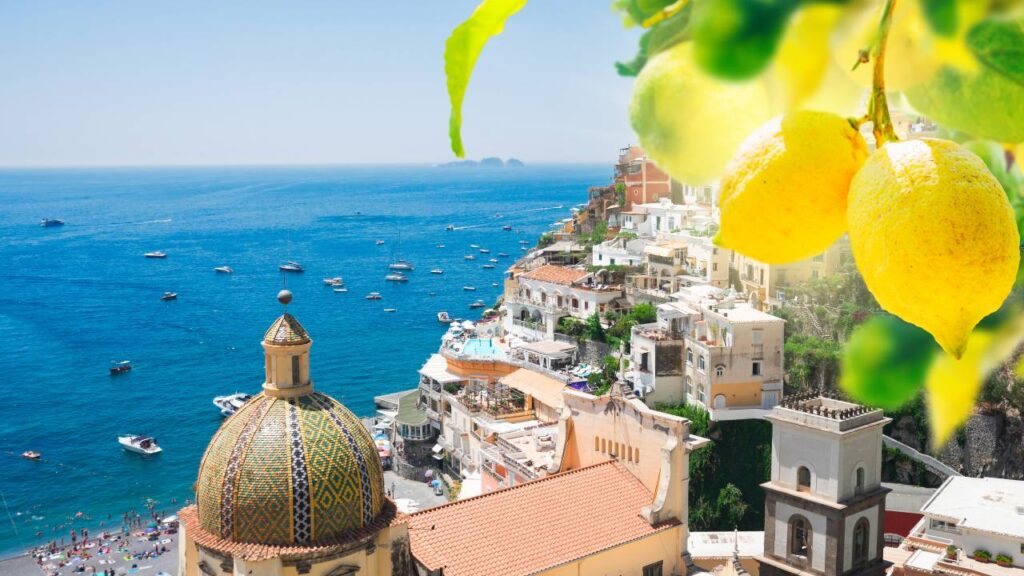
The Church of Santa Maria Assunta, with its iconic dome tiled in green and yellow majolica, stands as a centerpiece of the town. Inside, the church features beautiful Byzantine artwork and a tranquil interior. Down by the beach, you can relax on the black-sand Spiaggia Grande, browse through designer boutiques and artisan shops, or sit at a seaside café enjoying a glass of local wine as boats bob in the harbor. The town’s lively yet relaxed vibe makes it a perfect place to soak in the coastal beauty.
7. Stay at an Agriturismo
Immerse yourself in the authentic Italian countryside experience by choosing to stay at an agriturismo. These working farms not only provide a cozy place to sleep but also allow you to engage with the traditions of rural life. Nestled among terraced vineyards, olive groves, or lemon orchards, agriturismos offer a peaceful setting far from the busy coastal towns.
Wake up to the sounds of birds and the scent of blooming citrus trees, then join your hosts for a homemade breakfast made with fresh, seasonal ingredients straight from the farm. Many of these properties offer additional experiences such as wine tasting, cooking classes, or even participating in the olive or grape harvest.
Learn to make pasta by hand, bake traditional desserts, or prepare fresh tomato sauce from scratch. Staying at an agriturismo not only supports local families but also gives you a deeper connection to the land and culture of the region.
8. Drive the Amalfi Coast Road
Embark on an unforgettable journey along the Amalfi Coast Road—officially known as the SS163—as it winds its way through cliffs and coves, offering panoramic views at nearly every turn. This coastal drive is often considered one of the most scenic in the world, but it demands your full attention. As you navigate the twists and turns, you’ll pass through quaint villages, spot terraced vineyards clinging to the mountainsides, and gaze out at endless stretches of turquoise sea.
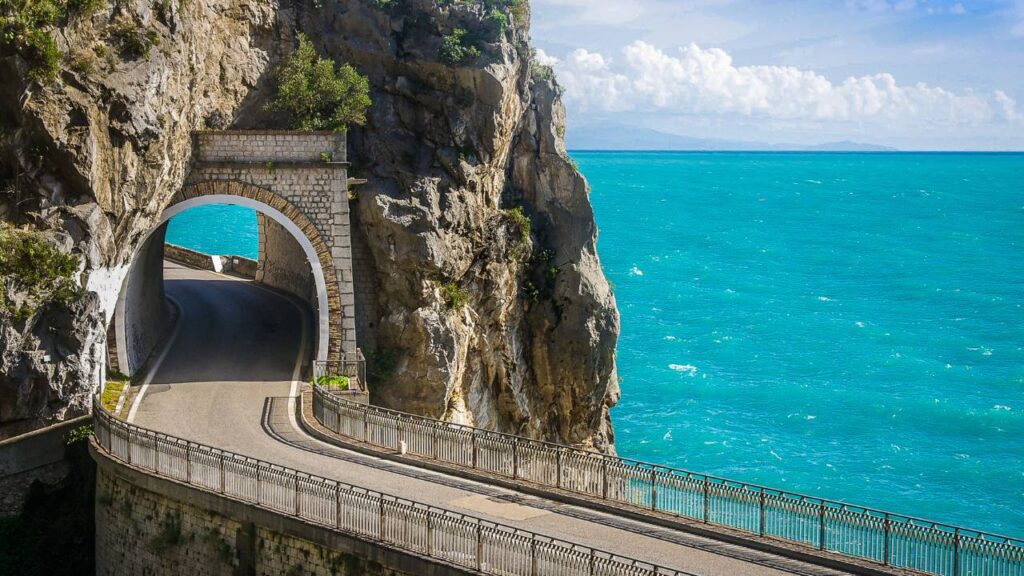
Driving early in the morning or around sunset not only helps avoid the heavy daytime traffic but also bathes the coast in golden light, enhancing its natural beauty. If you’re not confident behind the wheel on narrow roads with sharp curves, consider hiring a local driver or joining a private tour.
Either way, the drive delivers an immersive experience filled with photo-worthy stops, local roadside eateries, and a chance to appreciate the raw, rugged splendor of this UNESCO-listed coastline.
9. Visit Capri
Just a short ferry or boat ride away from the Amalfi Coast, the island of Capri invites you into a world of Mediterranean elegance and natural wonder. Once a favorite retreat for Roman emperors, Capri continues to enchant travelers with its stunning landscapes and upscale atmosphere. Upon arrival, you can embark on a boat tour around the island, gliding past sea stacks and sea caves, with a stop at the famous Blue Grotto where sunlight reflects off the water, casting an ethereal blue glow inside the cave.
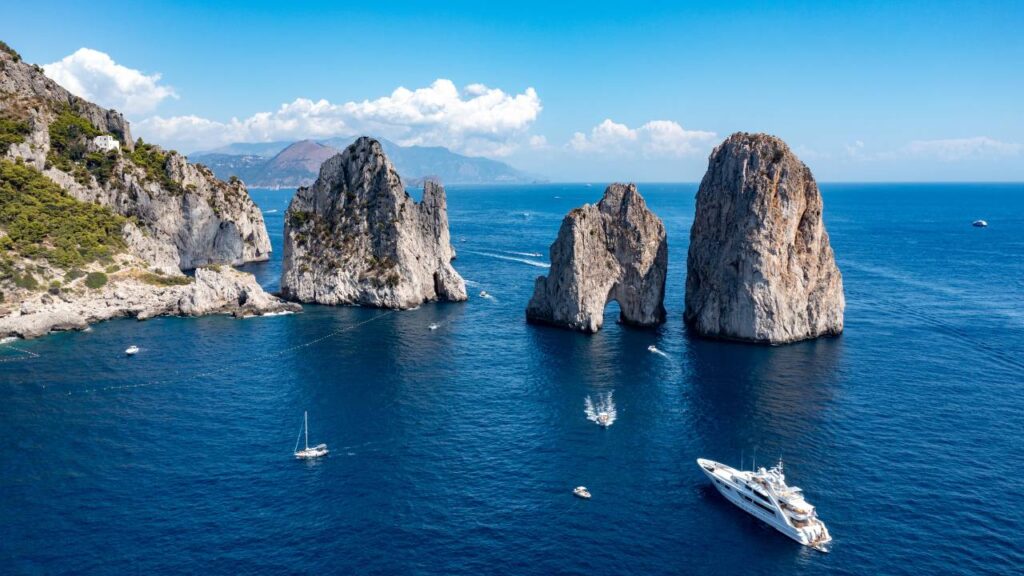
Venture up to Anacapri, the quieter part of the island, and ride the chairlift up Mount Solaro for unmatched panoramic views stretching all the way to the mainland. The main town of Capri is bustling with designer boutiques, gelato stands, and open-air cafés where you can relax in style.
10. Spot Vesuvius
Mount Vesuvius looms in the distance like a silent sentinel, its presence both awe-inspiring and historically significant. From many points along the Amalfi Coast—especially Sorrento—you can see the distinctive cone of this famous volcano rising above the Bay of Naples. More than just a scenic backdrop, Vesuvius is a living volcano with a dramatic history, most notably its eruption in 79 AD that buried the cities of Pompeii and Herculaneum.
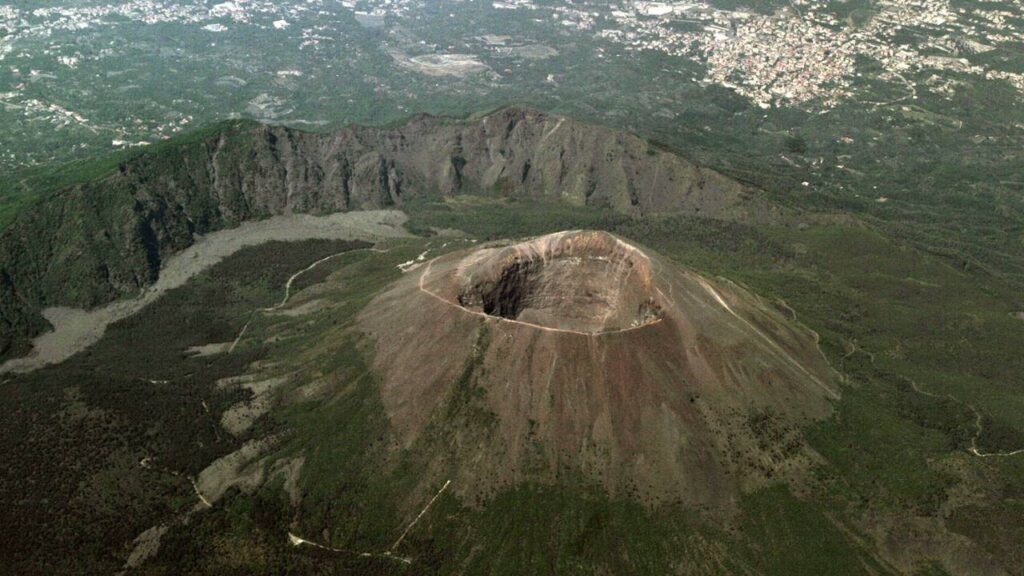
Those with a sense of adventure, a visit to Vesuvius provides a rare opportunity to hike an active volcano. Drive or take a tour to the Vesuvius National Park, then hike the well-marked trail that leads to the crater. As you reach the summit, steam still rises from vents in the ground, and the vast, lunar-like crater stretches out before you.
On a clear day, the view from the top includes Naples, the bay, and the islands beyond. Standing at the edge of this mighty volcano, you can’t help but feel the weight of history and the power of nature.
11. Go Hiking

The Amalfi Coast offers some of the best hiking trails in Italy, with paths that offer breathtaking views of the sea and the surrounding mountains. The most famous hike is the Path of the Gods (Sentiero degli Dei), which runs from Bomerano to Nocelle, high above the coastline. The trail offers panoramic vistas and takes about 2–3 hours to complete. There are also shorter hikes near Ravello and Minori that are perfect for casual walkers.
12. Relax on the Beach
Amalfi Coast offers a wide variety of beaches, each with its own character and charm. While many of the coastal stretches are composed of pebbles or smooth rocks, they more than make up for it with their postcard-perfect scenery and clear, turquoise waters. Spiaggia Grande in Positano is one of the most iconic beaches in the region, lined with colorful umbrellas, lively beach bars, and framed by the town’s cascading pastel buildings.

Marina Grande in Amalfi provides a more family-friendly vibe, with soft sand, calm waves, and easy access to the town’s amenities. You can rent a lounge chair, sip on a cold limoncello spritz, and enjoy watching yachts drift in and out of the harbor. Swimming, sunbathing, or reading under a parasol, relaxing on these sun-drenched shores is one of the most rewarding and rejuvenating experiences the coast has to offer.
13. See Castellammare di Stabia
Step off the beaten path and visit the quiet elegance of Castellammare di Stabia, a historic coastal town nestled near the more famous ruins of Pompeii. This town boasts its own impressive archaeological heritage, including the Stabian Baths—ancient Roman thermal structures that reveal a fascinating glimpse into daily life in antiquity.
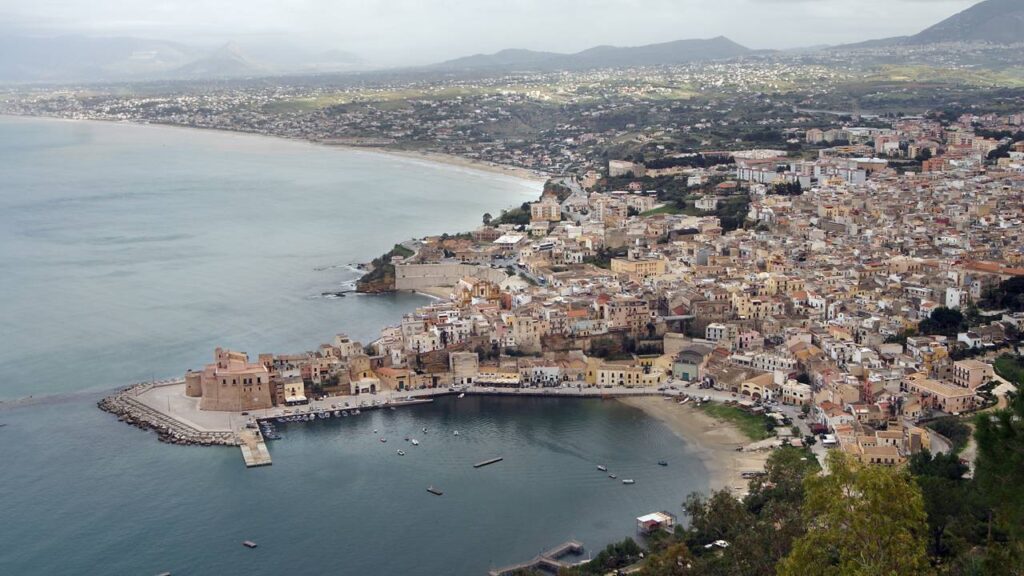
As you wander the town’s charming streets, you’ll encounter classic Italian piazzas, old churches, and waterfront promenades with breathtaking views of Mount Vesuvius. Unlike its more tourist-heavy neighbors, Castellammare di Stabia offers a more local and authentic feel, where you can enjoy fresh seafood at a harborfront trattoria or sip espresso in a quiet café. The pace here is slower, the prices more reasonable, and the atmosphere more relaxed—making it a rewarding detour for curious travelers.
14. View Capri from the Coast
Even if you don’t set foot on the island of Capri, the views of it from the Amalfi Coast are nothing short of mesmerizing. From elevated spots in Positano, the romantic gardens of Ravello, or the bustling port of Amalfi, you can gaze across the sea and spot the rocky silhouette of Capri rising from the blue horizon.
The sight becomes even more magical at sunrise or sunset, when the golden light casts dramatic shadows on the island’s cliffs and highlights the luxurious villas perched along its edges. For an even more intimate perspective, consider joining a coastal boat tour. As you glide along the water, you’ll enjoy uninterrupted views of Capri’s iconic Faraglioni rock formations and lush green hills.
These views serve as a perfect reminder of the region’s natural splendor and make for some of the most unforgettable photo opportunities on your trip.
15. Shop Fresh Produce
Amalfi Coast isn’t just a feast for the eyes—it’s a paradise for food lovers, thanks in large part to its incredibly fresh and flavorful produce. The region is especially renowned for its plump tomatoes, rich olive oil, and most famously, its vibrant lemons, which flourish in the sun-drenched groves that dot the hillsides. Find local markets in almost every town, where vendors set up colorful stalls brimming with seasonal fruits, vegetables, herbs, and handmade goods.
In Amalfi and Positano, you can browse morning markets and pick up juicy peaches, fragrant basil, or a bag of just-picked olives. Don’t miss the chance to buy homemade pasta, sun-dried tomatoes, and local cheeses as edible souvenirs. And, of course, no visit is complete without picking up a bottle (or two) of limoncello—the bright, zesty liqueur that perfectly captures the flavor of the coast.
16. Take a Boat Tour
There’s no better way to appreciate the full glory of the Amalfi Coast than from the sea, and a boat tour lets you do just that—while adding a sense of adventure and luxury to your journey. These tours vary in length and style, from half-day group cruises to private full-day charters, but all of them offer a unique and memorable experience.
As your boat glides through the sparkling waters, you’ll pass hidden beaches, dramatic cliffs, and charming villages built into the rock. Many tours allow time for swimming in secluded coves, snorkeling near rocky outcrops, or sunbathing on the deck while sipping prosecco. Some even include stops at coastal towns or Capri’s Blue Grotto, where sunlight creates an electric-blue underwater glow inside the sea cave.
17. Drink Limoncello
No trip to the Amalfi Coast would be complete without tasting its most iconic drink—limoncello. This sweet, lemony liqueur is traditionally made using Sfusato Amalfitano lemons, a special variety grown only in this region, known for their intense aroma and elongated shape. The process is a labor of love: lemon peels are steeped in pure alcohol, then mixed with sugar and water to create a vibrant, golden digestif that’s best served ice-cold after a meal.

Find limoncello everywhere—from chic cafes in Ravello to roadside stands in Minori. Many local distilleries offer tastings, and some even give behind-the-scenes tours of the production process. Take a few small sips and let the crisp citrus flavor dance on your palate—it’s refreshing, flavorful, and packed with the essence of the Amalfi sunshine. Bringing home a bottle makes for the perfect way to carry a taste of your trip with you.
Santorini, Greece: Best Things To Do & Complete Travel Guide
FAQs
1. What are the must-see towns on the Amalfi Coast?
The top towns to visit on the Amalfi Coast include:
- Positano – Famous for its pastel-colored cliffside homes, boutique shops, and romantic vibe.
- Amalfi – A historic town with a stunning cathedral and a rich maritime heritage.
- Ravello – Known for its panoramic gardens and elegant villas like Villa Rufolo and Villa Cimbrone.
- Praiano – A quieter alternative to Positano with incredible sunsets and coastal views.
- Minori & Maiori – Great for family-friendly beaches and authentic local cuisine.
Each town has its unique charm, and you can experience many of them in a few days.
2. What is the best time to visit the Amalfi Coast?
The best time to visit is during the shoulder seasons:
- April to early June and September to October.
During these months, the weather is pleasant, prices are more reasonable, and the crowds are smaller. July and August are peak tourist months, with higher prices and heavy crowds. Winter months (November to March) see limited tourist activity, with some businesses closed.
3. How many days should I spend on the Amalfi Coast?
For a well-rounded experience, plan to spend at least 4 to 5 days. This allows time to:
- Visit several towns
- Take a boat trip or coastal hike
- Visit nearby attractions like Pompeii or Capri
- Enjoy leisure time at the beach or in local cafés
If you’re short on time, a 3-day trip can still give you a solid taste of the coast.
4. Is it better to stay in one place or move around the coast?
It depends on your travel style:
- Stay in one town (like Positano, Amalfi, or Sorrento) if you want a base and prefer day trips.
- Move around if you’re looking to experience the unique atmosphere of each town.
Many travelers choose two towns, like Positano and Ravello, to balance beach and relaxation with exploration.
5. What are the top outdoor activities on the Amalfi Coast?
Top outdoor experiences include:
- Hiking the Path of the Gods (Sentiero degli Dei) – A scenic trail with sweeping views.
- Boat tours along the coast or to Capri.
- Swimming or sunbathing at beaches like Spiaggia Grande (Positano) and Marina di Praia (Praiano).
- Exploring sea caves and grottos by kayak or boat.
- Driving or scootering along the winding Amalfi Coast road.
These activities highlight the natural beauty of the coast and its stunning landscapes.
6. Can I visit Pompeii or Mount Vesuvius from the Amalfi Coast?
Yes! Day trips to Pompeii and Mount Vesuvius are very popular.
- From Sorrento, you can take a direct train to Pompeii.
- Private drivers and guided tours are also available from other towns.
- To climb Mount Vesuvius, you can take a shuttle from Pompeii.
It’s best to dedicate a full day for this historical and adventurous outing.
7. Is Amalfi Coast family-friendly?
Yes, but with some caveats:
- Towns like Minori, Maiori, and Amalfi are more family-friendly with easier terrain and wider walkways.
- Positano and Ravello have many stairs and steep slopes, which may be challenging for strollers or young children.
- Beaches, boat trips, and gelato stops are sure to please kids.
- Consider staying in towns with flatter landscapes for more comfort with children.
8. Do I need a car on the Amalfi Coast?
Not necessarily. In fact, not having a car is often more convenient due to:
- Limited parking and narrow roads
- Heavy traffic in high season
- Excellent public transport options (buses, ferries, and taxis)
If you prefer flexibility, hiring a private driver for day trips is a great alternative. Many travelers rely on ferries and buses for easy navigation between towns.
9. What food should I try while on the Amalfi Coast?
Must-try dishes include:
- Fresh seafood pasta – Especially “Scialatielli ai Frutti di Mare”
- Neapolitan-style pizza
- Delizie al Limone – A lemon cream sponge cake
- Sfogliatella – A crispy pastry filled with ricotta
- Limoncello – The famous local lemon liqueur
Restaurants often highlight locally sourced ingredients and traditional southern Italian recipes.
10. Is Capri worth visiting during a trip to the Amalfi Coast?
Absolutely. Capri is a popular day-trip destination from towns like Positano, Sorrento, and Amalfi. Highlights include:
- The Blue Grotto – A magical sea cave with glowing blue water
- Villa Jovis – The ancient palace of Emperor Tiberius
- Monte Solaro – The highest point on the island, reachable by chairlift
- Luxury shopping and cafés in Capri town
Boat tours to Capri often include time for swimming and exploring hidden coves.
